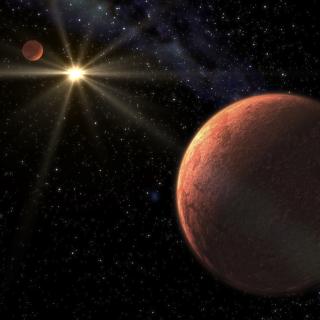Bibcode
Kuzuhara, Masayuki; Fukui, Akihiko; Livingston, John H.; Caballero, José A.; de Leon, Jerome P.; Hirano, Teruyuki; Kasagi, Yui; Murgas, Felipe; Narita, Norio; Omiya, Masashi; Orell-Miquel, Jaume; Palle, Enric; Changeat, Quentin; Esparza-Borges, Emma; Harakawa, Hiroki; Hellier, Coel; Hori, Yasunori; Ikuta, Kai; Ishikawa, Hiroyuki Tako; Kodama, Takanori; Kotani, Takayuki; Kudo, Tomoyuki; Morales, Juan C.; Mori, Mayuko; Nagel, Evangelos; Parviainen, Hannu; Perdelwitz, Volker; Reiners, Ansgar; Ribas, Ignasi; Sanz-Forcada, Jorge; Sato, Bun'ei; Schweitzer, Andreas; Tabernero, Hugo M.; Takarada, Takuya; Uyama, Taichi; Watanabe, Noriharu; Zechmeister, Mathias; Abreu García, Néstor; Aoki, Wako; Beichman, Charles; Béjar, Víctor J. S.; Brandt, Timothy D.; Calatayud-Borras, Yéssica; Carleo, Ilaria; Charbonneau, David; Collins, Karen A.; Currie, Thayne; Doty, John P.; Dreizler, Stefan; Fernández-Rodríguez, Gareb; Fukuda, Izuru; Galán, Daniel; Geraldía-González, Samuel; González-Garcia, Josafat; Hayashi, Yuya; Hedges, Christina; Henning, Thomas; Hodapp, Klaus; Ikoma, Masahiro; Isogai, Keisuke; Jacobson, Shane; Janson, Markus; Jenkins, Jon M.; Kagetani, Taiki; Kambe, Eiji; Kawai, Yugo; Kawauchi, Kiyoe; Kokubo, Eiichiro; Konishi, Mihoko; Korth, Judith; Krishnamurthy, Vigneshwaran; Kurokawa, Takashi; Kusakabe, Nobuhiko; Kwon, Jungmi; Laza-Ramos, Andrés; Libotte, Florence; Luque, Rafael; Madrigal-Aguado, Alberto; Matsumoto, Yuji; Mawet, Dimitri; McElwain, Michael W.; Meni Gallardo, Pedro Pablo; Morello, Giuseppe; Muñoz Torres, Sara; Nishikawa, Jun; Nugroho, Stevanus K.; Ogihara, Masahiro; Peláez-Torres, Alberto; Rapetti, David; Sánchez-Benavente, Manuel; Schlecker, Martin; Seager, Sara; Serabyn, Eugene; Serizawa, Takuma; Stangret, Monika; Takahashi, Aoi; Teng, Huan-Yu; Tamura, Motohide; Terada, Yuka; Ueda, Akitoshi et al.
Referencia bibliográfica
The Astrophysical Journal
Fecha de publicación:
6
2024
Revista
Número de citas
16
Número de citas referidas
13
Descripción
Recent discoveries of Earth-sized planets transiting nearby M dwarfs have made it possible to characterize the atmospheres of terrestrial planets via follow-up spectroscopic observations. However, the number of such planets receiving low insolation is still small, limiting our ability to understand the diversity of the atmospheric composition and climates of temperate terrestrial planets. We report the discovery of an Earth-sized planet transiting the nearby (12 pc) inactive M3.0 dwarf Gliese 12 (TOI-6251) with an orbital period (P orb) of 12.76 days. The planet, Gliese 12 b, was initially identified as a candidate with an ambiguous P orb from TESS data. We confirmed the transit signal and P orb using ground-based photometry with MuSCAT2 and MuSCAT3, and validated the planetary nature of the signal using high-resolution images from Gemini/NIRI and Keck/NIRC2 as well as radial velocity (RV) measurements from the InfraRed Doppler instrument on the Subaru 8.2 m telescope and from CARMENES on the CAHA 3.5 m telescope. X-ray observations with XMM-Newton showed the host star is inactive, with an X-ray-to-bolometric luminosity ratio of $\mathrm{log}{L}_{{\rm{X}}}/{L}_{\mathrm{bol}}\approx -5.7$ . Joint analysis of the light curves and RV measurements revealed that Gliese 12 b has a radius of 0.96 ± 0.05 R ⊕, a 3σ mass upper limit of 3.9 M ⊕, and an equilibrium temperature of 315 ± 6 K assuming zero albedo. The transmission spectroscopy metric (TSM) value of Gliese 12 b is close to the TSM values of the TRAPPIST-1 planets, adding Gliese 12 b to the small list of potentially terrestrial, temperate planets amenable to atmospheric characterization with JWST.
Proyectos relacionados

Estrellas de Baja Masa, Enanas Marrones y Planetas
Se investigan los procesos que conducen a la formación de estrellas de baja masa, enanas marrones y exoplanetas y caracterizar las propiedades físicas de estos astros en varias etapas evolutivas. Las estrellas de muy baja masa y las enanas marrones son probablemente los objetos más numerosos de nuestra Galaxia, pero no por ello están
Rafael
Rebolo López

Exoplanetas y Astrobiología
La búsqueda de vida en el Universo se ha visto impulsada por los recientes descubrimientos de planetas alrededor de otras estrellas (los llamados exoplanetas), convirtiéndose en uno de los campos más activos dentro de la Astrofísica moderna. En los últimos años los descubrimientos cada vez más numerosos de nuevos exoplanetas y los últimos avances
Enric
Pallé Bago